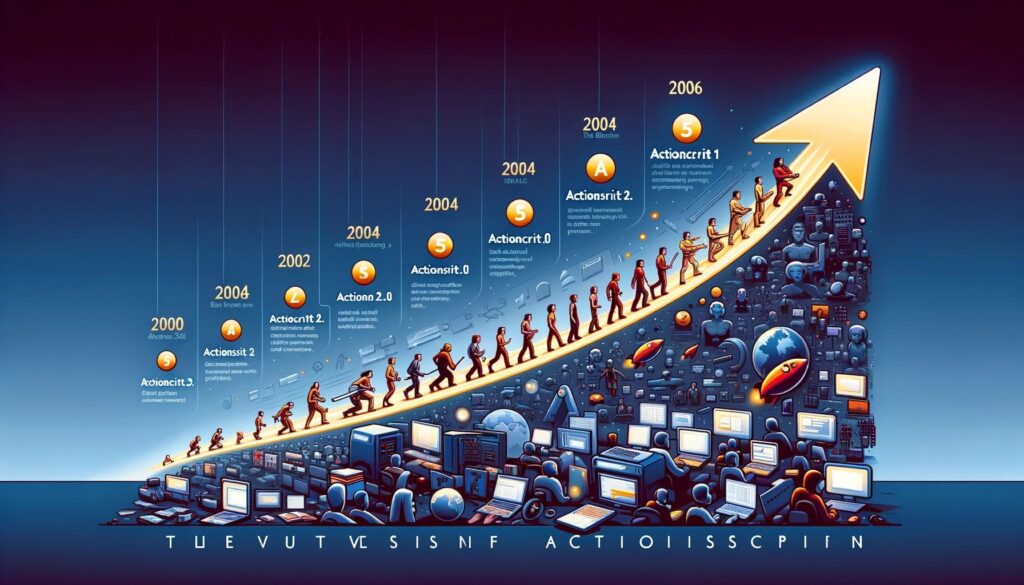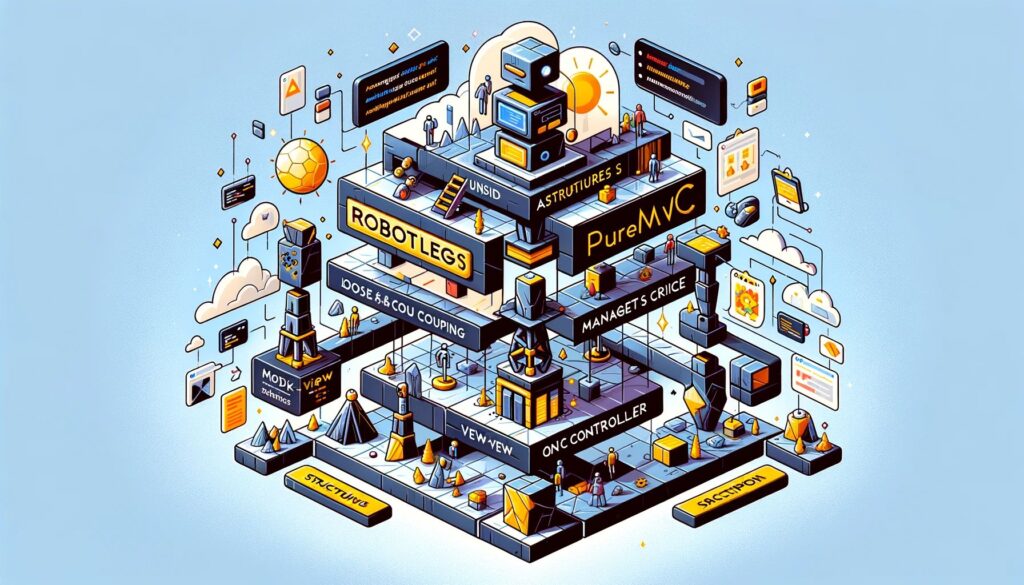Introduction to ActionScript: A Brief Overview
ActionScript, a scripting language initially developed by Macromedia, has undergone a significant evolution since its inception. It was primarily used for the development of websites and software using the Adobe Flash platform. However, with the gradual phase-out of Flash, ActionScript’s role in the programming world has shifted, yet it remains a pertinent tool in certain niches, particularly in legacy systems and specific gaming environments.
The Origins and Evolution of ActionScript

ActionScript made its debut with Flash 5 in 2000. Initially, it was a simple scripting tool designed to complement Flash’s animation features. As the internet and multimedia technologies evolved, so did ActionScript. It progressed through several iterations:
- ActionScript 1.0: Introduced with Flash 5, focused on basic control structures and operations.
- ActionScript 2.0: Launched with Flash MX 2004, it brought a more robust programming model with class-based syntax, promoting object-oriented programming principles.
- ActionScript 3.0: Released with Adobe Flash Player 9 in 2006, this version marked a significant overhaul. It offered improved performance, better error handling, and a more comprehensive set of programming tools.
ActionScript in Today’s Programming Landscape
Despite Adobe discontinuing Flash Player in 2020, ActionScript 3.0 remains in use, primarily due to its integration into the Adobe AIR platform. Adobe AIR allows developers to create desktop and mobile applications, thus extending the life of ActionScript-based projects. It’s particularly prevalent in the development of certain types of games, especially those that were originally created for the Flash platform but have since been ported to newer technologies.
The Role of ActionScript in Modern Development
While newer technologies have overshadowed ActionScript in web development, it still holds value in specific areas:
- Legacy Systems: Many businesses still operate on legacy systems that were built using Flash and ActionScript. Maintaining and updating these systems often requires proficiency in ActionScript.
- Game Development: The gaming industry occasionally utilizes ActionScript for creating or maintaining games, especially those initially developed for Flash but now ported to platforms like HTML5 using tools such as CreateJS.
- Educational and Interactive Content: ActionScript’s ease of use and animation capabilities make it suitable for interactive educational content and simple web-based games.
The Transition to Modern Technologies
The decline of Flash has necessitated a shift to modern technologies. Many ActionScript developers have transitioned to JavaScript, HTML5, and other web technologies that offer similar functionalities with broader support and more robust features. This transition reflects a general trend in the programming world, where languages and technologies are constantly evolving to meet the changing demands of the industry.
Key ActionScript Libraries: Enhancing Functionality
ActionScript libraries extend the core functionalities of the language, allowing developers to achieve more with less code. These libraries encompass a wide range of features, from enhanced user interface components to complex data handling. Understanding and utilizing these libraries can significantly enhance the efficiency and capability of ActionScript-based projects.
GreenSock Animation Platform (GSAP)
GSAP stands out as one of the most powerful animation libraries available for ActionScript. It’s widely acclaimed for its speed, flexibility, and ease of use. GSAP makes it simple to create complex animations and effects that would be cumbersome to code from scratch.
Example Code Snippet:
import com.greensock.TweenMax;
import com.greensock.easing.*;
TweenMax.to(myObject, 1.5, {x:300, ease:Bounce.easeOut});
This code animates myObject to move horizontally across the screen with a bounce effect, showcasing the simplicity and power of GSAP.
Starling Framework
The Starling Framework is a game changer for game developers using ActionScript. It’s an open-source engine specifically designed for 2D game development, allowing the creation of highly interactive and visually rich games.
Away3D
Away3D is a popular framework for creating 3D content in ActionScript. It’s used for everything from simple 3D animations to complex, interactive 3D environments, demonstrating the versatility of ActionScript in handling diverse graphical requirements.
Feather UI
Feather UI is a library of lightweight, skinnable, and extensible UI components for mobile and desktop. It integrates seamlessly with Starling Framework, making it a favorite for developing user interfaces in game and application development.
Frameworks in ActionScript: Structuring Success
Frameworks provide a structured way to develop applications, ensuring consistency, maintainability, and efficiency. In the world of ActionScript, several frameworks have stood out for their robustness and ease of use.

Robotlegs
Robotlegs is a highly modular, open-source application framework for ActionScript. It emphasizes loose coupling, simplifying the management of complex applications and promoting more manageable and testable code.
PureMVC
PureMVC is a lightweight framework that implements the Model-View-Controller (MVC) design pattern. It’s been widely adopted due to its simplicity and ease of understanding, making it a good choice for developers new to using frameworks in ActionScript.
Flex
Although originally a product of Adobe, Flex has evolved into an open-source framework. It’s particularly well-suited for building rich internet applications, combining ActionScript with an XML-based user interface markup language called MXML.
Flex Example Code Snippet:
<mx:Application xmlns:mx="http://www.adobe.com/2006/mxml">
<mx:Label text="Hello, Flex!" />
</mx:Application>
This snippet demonstrates a basic Flex application displaying a label, illustrating the blend of MXML and ActionScript in creating user interfaces.
Emerging Trends in ActionScript Development
While ActionScript isn’t at the forefront of mainstream web development anymore, it’s experiencing specific trends, particularly in niche areas such as game development and educational content.
The Rise of HTML5 and JavaScript
A significant trend is the migration of Flash-based content to HTML5 and JavaScript. This shift is driven by the broader support and capabilities of these technologies. Developers often use tools like Apache Royale (formerly FlexJS) to convert ActionScript code into JavaScript, ensuring legacy content remains usable and relevant.
Apache Royale Example Code:
// ActionScript code
public function sayHello():String {
return "Hello, World!";
}
// Equivalent JavaScript code after conversion
function sayHello() {
return "Hello, World!";
}
This example illustrates how a basic function in ActionScript can be translated into JavaScript, enabling a smoother transition to modern web technologies.
ActionScript in Mobile App Development
With Adobe AIR, ActionScript is still a viable option for mobile app development. AIR allows for the creation of standalone apps for platforms like iOS and Android, leveraging existing ActionScript skills and codebases.
Integration with Newer Technologies
Developers are finding innovative ways to integrate ActionScript with newer technologies. For instance, using ActionScript-based games within HTML5 environments, or combining it with WebAssembly for higher performance in web applications.
Case Studies: ActionScript in Real-World Applications
- Gaming: Many popular online games initially built in Flash have successfully transitioned to HTML5, still retaining their core ActionScript codebase. This showcases the adaptability of ActionScript in evolving technological landscapes.
- Educational Tools: Interactive learning modules developed in ActionScript continue to be used in educational platforms, often encapsulated within modern web technologies to ensure compatibility and reach.
Best Practices for Implementing ActionScript Libraries and Frameworks

- Code Organization: Keeping code modular and well-organized is crucial. Using frameworks like Robotlegs or PureMVC can aid in maintaining a clean codebase.
- Performance Optimization: Pay attention to performance, especially when dealing with complex animations or 3D graphics. Efficient use of libraries like GSAP and Away3D is key.
- Cross-Platform Compatibility: Ensure that applications developed with Adobe AIR are thoroughly tested across different devices for a consistent user experience.
- Future-Proofing: Be prepared for future transitions by keeping abreast of emerging technologies and trends. Consider the feasibility of porting ActionScript applications to newer platforms.
Resources and Communities for Learning and Collaboration
- Adobe Developer Connection: Offers a wealth of resources for ActionScript developers, including tutorials, documentation, and forums.
- GitHub Repositories: A hub for open-source ActionScript projects and libraries.
- Online Forums: Platforms like Stack Overflow have active communities for troubleshooting and sharing knowledge about ActionScript.
Conclusion: The Future of ActionScript
ActionScript, with its rich history in web development and multimedia creation, still finds relevance in certain areas despite the dominance of newer technologies. The continued use of ActionScript libraries and frameworks in niche applications, the transition of legacy content to modern platforms, and the sustained interest of a dedicated developer community ensure that ActionScript remains an interesting chapter in the ongoing story of web development. Understanding its past, present, and potential future underscores the dynamic and adaptable nature of programming languages and the importance of staying flexible and open to change in the tech industry.




